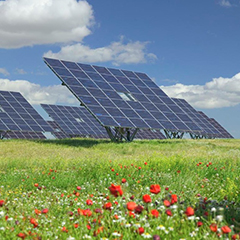Part of the European EUREKA Technology Cooperation Program, the OPTIMUS project will last three years and is part funded by the CDTI.
* The OPTIMUS project, which is led by MECASOLAR and also includes the participation of ACF and ISTON, will represent a technological leap by improving polymer and cement-based composites, obtaining materials that are more resistant, durable and lighter, yielding improved solar PV tracker performance.
* Total investment in the project, which has just started, exceeds 830,000 Euros, and is part funded by the Centre for Industrial Technological Development (CDTI).
* MECASOLAR has expressed its satisfaction at leading this international R&D project, which is set to provide answers to solar industry technology requirements for PV tracker weight reduction and material consumption.
12 June 2013. The European Union has launched a new research project called OPTIMUS, part of the EUREKA Technology Cooperation Program, which over the next three years will focus on the research and development of new materials to be applied to solar trackers, in order to maximise their efficiency. With a total budget of 830,577 euros – part funded by CDTI – the international project is led by MECASOLAR and also includes the participation of Advanced Composite Fibers (ACF) and ISTON.
The project aims to respond to solar industry technology requirements, providing products that are competitive in terms of their cost, with reduced material consumption, tracker weight and construction times. In this sense, the project’s multidisciplinary nature will enable knowledge to be generated and advances to be made in the field of polymer and cement-based composites, focused on solar tracker manufacture.
To achieve this, the three project participant companies, led by MECASOLAR, will work together during the next three years: MECASOLAR (Spain), a multinational specialising in the manufacture and design of solar trackers, fixed ground and roof structures and foundation bolts for large solar PV plants; ACF (Spain), specialising in the commercialisation, consultancy, design and execution of high performance solutions based on Carbon-fiber-reinforced-polymer (CFRP) and glass fiber (GFRP); together with ISTON (Turkey), specialising in cement and concrete prefabricated elements.
MECASOLAR – leader in its sector with solar trackers and fixed structures used in over 500 projects in 50 countries – underlines that the development of the OPTIMUS project will constitute a leap in terms of solar tracker technology and materials, “to provide some of the answers to user needs and the disadvantages of the materials currently employed for tracker construction”.
Notable aspects improved by composites compared to current materials (galvanised steel) include the following: a 30% reduction in structure weight, which currently ranges between 1,920 and 2,225 kg; greater corrosion resistance in aggressive environments, increasing tracker durability given that composites have a greater resistance to chemical and organic/inorganic agents; and reduced tracker maintenance costs, with tracker life expected to be identical to that of solar panels.
The MECASOLAR R&D department has highlighted that the main OBJECTIVES OF THE OPTIMUS project led by the multinational are as follows:
– The development of materials with a greater resistance to climate fluctuations which are adaptable to extreme weather conditions (for use in the desert, during monsoons, etc.).
– Reduced use of resources and material costs by optimising the use of fibers without losing mechanical efficiency; improved impregnability and cohesion between fibers and polymer matrix.
– Increased durability.
– UV ray, fire and humidity resistance.
– Improved composite lightness and compactness.
– Reduced use of resources and material costs by optimising the use of reinforcements (short polymer or metallic fibres) without losing mechanical efficiency; and due to the improved interaction between cement and aggregates.
– Material adaptation to different ground types and improved ground interaction.
– A reduction in pathologies associated with chemical agent penetration (corrosion, carbonatation, etc.).
– Material optimisation yielding improved cost efficiency, reducing manufacturing costs and production times.
– Improved energy efficiency and reduced environmental impact throughout the solar tracker installation life cycle, reducing energy consumption both during the production and transportation of materials.
– Improved product quality and performance, compared to traditional structural designs with no service life analysis, based on cost effective production systems.
– Carbon footprint and energy requirement analysis based on treatment and production processes for the new proposed materials compared to materials traditionally employed for solar trackers.



























